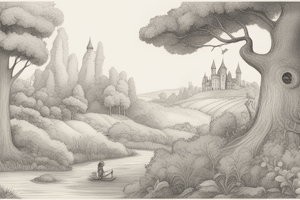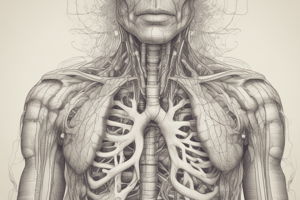Podcast
Questions and Answers
What is the primary function of Type II alveolar cells?
What is the primary function of Type II alveolar cells?
- Produce surfactant to reduce surface tension (correct)
- Remove foreign particles and debris from the alveoli
- Facilitate gas exchange by increasing surface area
- Provide structural support for the alveoli
Which of the following factors directly affects the rate of diffusion of gases across the respiratory membrane?
Which of the following factors directly affects the rate of diffusion of gases across the respiratory membrane?
- The partial pressure gradient of the gases
- The thickness of the respiratory membrane
- The surface area of the respiratory membrane
- All of the above (correct)
What is the primary role of the chloride shift in the blood?
What is the primary role of the chloride shift in the blood?
- To facilitate the transport of oxygen to tissues
- To maintain pH balance by exchanging chloride ions for bicarbonate ions (correct)
- To regulate blood pressure by adjusting fluid volume
- To remove carbon dioxide from the body
Which of the following is a characteristic of emphysema, a component of COPD?
Which of the following is a characteristic of emphysema, a component of COPD?
What is the primary function of the respiratory center in the medulla oblongata?
What is the primary function of the respiratory center in the medulla oblongata?
Flashcards
Respiratory Zones
Respiratory Zones
Two areas of the respiratory system: respiratory zone (gas exchange) and conducting zone (air passage).
Alveoli Types
Alveoli Types
Alveoli contain Type I cells for gas exchange and Type II cells for surfactant production.
Boyle's Law
Boyle's Law
Boyle's Law states that pressure and volume of gas are inversely related at constant temperature.
External Respiration
External Respiration
Signup and view all the flashcards
Control of Breathing
Control of Breathing
Signup and view all the flashcards
Study Notes
Functions of the Respiratory System
- Supplies body with oxygen (O2) and eliminates carbon dioxide (CO2).
- Enables speech and other vocalizations.
Respiratory Zone vs. Conducting Zone, Upper vs. Lower Respiratory
- Conducting zone (nose to terminal bronchioles): warms, humidifies, and filters incoming air.
- Respiratory zone (respiratory bronchioles to alveoli): site of gas exchange.
- Upper respiratory tract: Nose, nasal cavity, pharynx.
- Lower respiratory tract: Larynx, trachea, bronchi, lungs.
Anatomy
Bronchioles
- Terminal bronchioles: End of conducting zone.
- Respiratory bronchioles: Start of respiratory zone.
Alveolar Ducts and Alveoli
- Alveoli: Tiny air sacs for gas exchange.
- Type I cells: Main site of gas exchange.
- Type II cells: Produce surfactant.
- Macrophages: Phagocytize inhaled particles.
- Alveolar fluid: Surrounds alveoli, important for gas exchange.
Lungs
- Bronchopulmonary segments: Lobules with independent blood supply.
- Lobules: Small compartments of lung tissue.
Respiratory Membrane
- 4 layers: Alveolar and capillary endothelia, their fused basal laminas.
- Characteristics: Thin for efficient diffusion.
Blood Flow Through Heart and Lungs (Pulmonary Circulation)
- Oxygen-poor blood pumped from right ventricle to pulmonary arteries to lungs.
- Oxygen-rich blood returns to left atrium via pulmonary veins.
Pulmonary Ventilation (Breathing)
- Boyle's Law: Pressure of a gas is inversely proportional to its volume.
- Inhalation (Inspiration): Thoracic cavity expands, decreasing pressure, causing air to flow in.
- Exhalation (Expiration): Thoracic cavity recoils, increasing pressure, forcing air out.
Muscles Used in Breathing
- Quiet breathing: Primarily diaphragm and intercostals.
- Labored breathing: Accessory muscles (sternocleidomastoid, scalene).
Factors Affecting Breathing
- Surface tension: Surfactant reduces tension in alveoli.
- Compliance: Ease with which lungs expand.
- Airway resistance: Resistance to airflow in airways.
External Respiration
- Occurs in alveoli.
- Dalton's Law: Total pressure of a mixture of gases is the sum of the individual pressures.
- Henry's Law: Amount of gas that dissolves in a liquid is proportional to its partial pressure.
- Diffusion of O2 and CO2: High pressure to low pressure.
- Factors affecting diffusion rate: Surface area, thickness of respiratory membrane, partial pressure difference.
Internal Respiration
- Occurs in body tissues.
- Blood → tissues: O2 diffuses out; CO2 diffuses in.
Oxygen Carried in Blood
- Dissolved: 1.5%.
- Hemoglobin (Hb): 98.5%
Hemoglobin Structure
- Complex protein with 4 heme groups, each containing an iron atom.
Factors Determining O2 Binding to Hemoglobin
- Partial pressure of O2 (PO2), temperature, pH, BPG (2,3-bisphosphoglycerate).
Carbon Dioxide Carried in Blood
- Plasma: 7%.
- Hemoglobin: 23%.
- Bicarbonate ion (HCO3-): 70%.
Control of Breathing
-
Respiratory Center in Brain: Medulla and pons.
- Medulla: Controls basic rhythm of breathing.
- Pons: Modifies and smooths breathing rhythm.
-
Regulation of Breathing: Other parts of brain, chemoreceptors, proprioceptors.
-
Chemoreceptors: Detect changes in blood gas levels (O2, CO2).
-
Proprioceptors: Detect body movement.
Other Factors Influencing Breathing Rate
- Emotions, pain, metabolic rate.
Effects of Exercise, Aging, and Smoking on Breathing
- Exercise: Increases breathing rate and depth.
- Aging: Decreases lung elasticity, reducing vital capacity.
- Smoking: Damages alveoli and airways, impairing gas exchange.
Diseases/Disorders of the Respiratory System
- Asthma: Inflammation and constriction of airways.
- COPD (Emphysema, Chronic Bronchitis, Lung Cancer): Progressive lung diseases.
- Coryza: Common cold.
- Influenza: Flu.
- Pneumonia: Infection of lung tissue.
- Tuberculosis: Bacterial infection of lungs.
- Cystic Fibrosis: Genetic disorder affecting mucus production.
Miscellaneous
- Capillaries: Tiny blood vessels surrounding alveoli for gas exchange.
- Chloride shift: Movement of chloride ions to maintain electrical balance during CO2 transport.
- Anemia: Reduced oxygen-carrying capacity of blood.
- CO poisoning: CO binds to hemoglobin, preventing O2 binding.
- Hypoxia: Inadequate oxygen delivery to tissues (various types).
- Patency: Openness of a passage.
- Eupnea: Normal breathing.
- Apnea: Temporary cessation of breathing.
- Dyspnea: Difficulty breathing.
- Tachypnea: Rapid breathing.
Studying That Suits You
Use AI to generate personalized quizzes and flashcards to suit your learning preferences.




